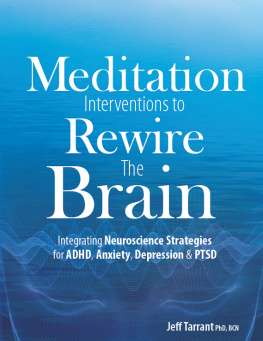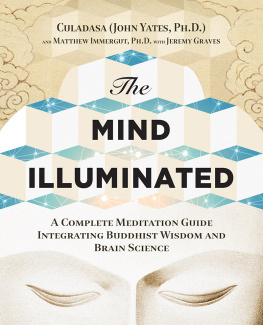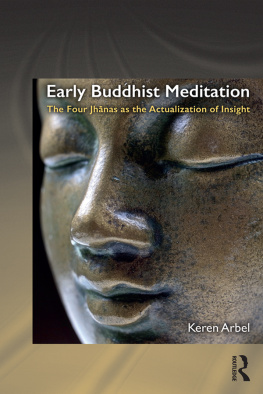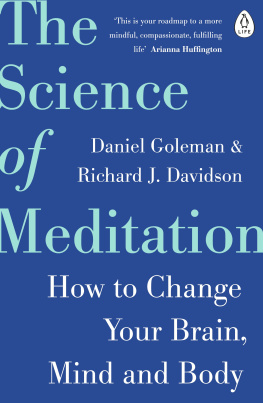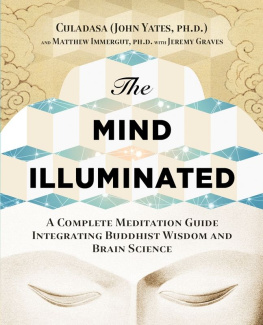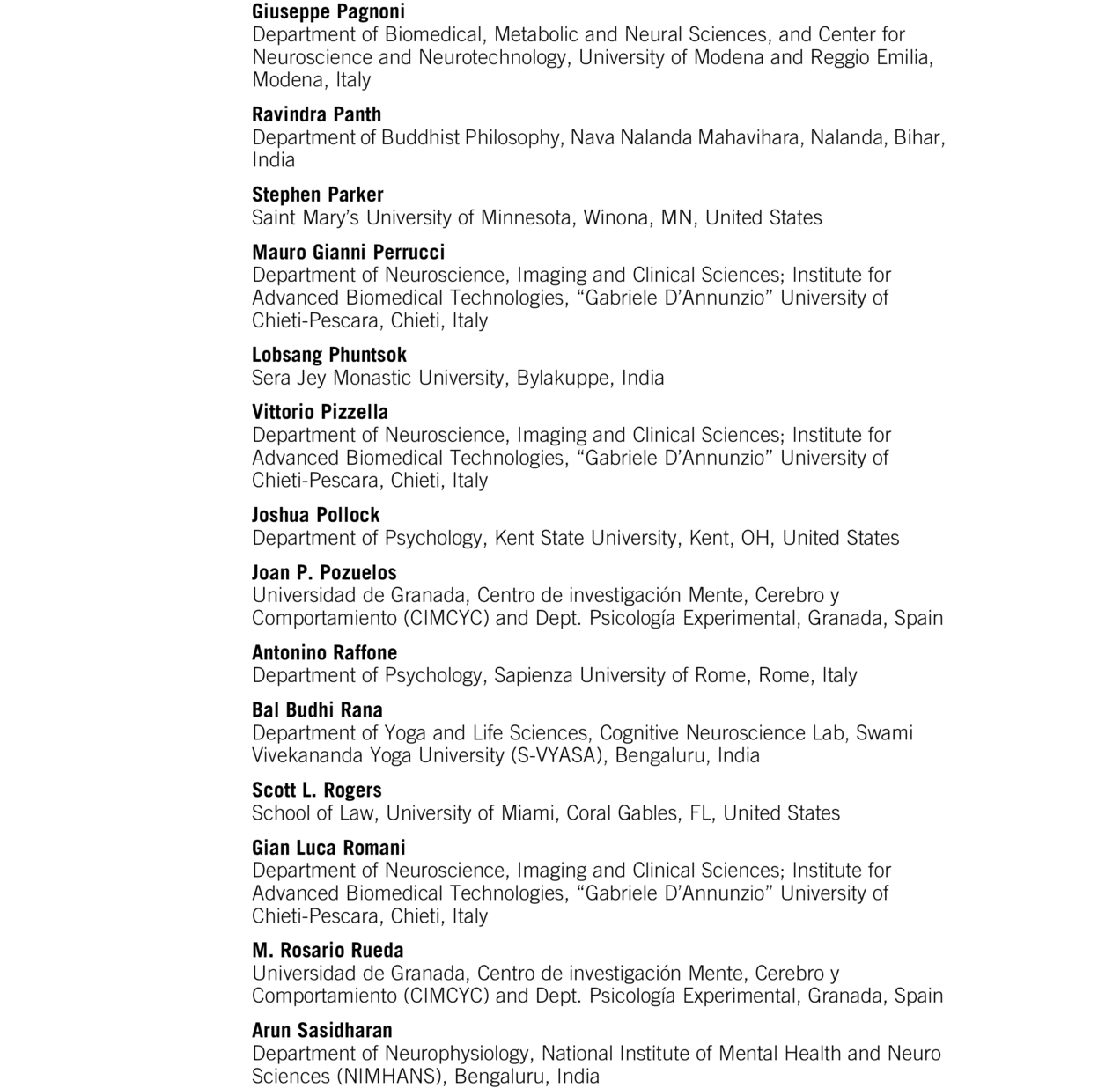Narayanan Srinivasan, Centre of Behavioural and Cognitive Sciences, University of Allahabad, Allahabad, India
Keywords
Meditation; Brain; Cognition; Attention; Consciousness; EEG; fMRI; Education; Military; Clinical disorders; Prediction
Meditation has been practiced for many centuries in multiple traditions throughout the world. There is a large classical literature on meditation training and states of consciousness that could be achieved through meditation practice and its putative beneficial effects. While mediation practice is old, scientific studies on meditation are only decades old and has expanded significantly in the past 20 years. The scientific studies on meditation have focused both on changes in brain and mind due to the practice as well as its benefits to those who suffer from mental disorders. The methodologies used to study meditation have also expanded ranging from experience based sampling, behavioral paradigms, questionnaires, eye tracking, electroencephalography, and brain imaging.
The volume arose out of the International Conference on Meditation held on March 46, 2018 at the Centre of Behavioural and Cognitive Sciences, University of Allahabad, Allahabad, India. The plenary speakers included Dr. Tal Dotan Ben-Soussan, Dr. Aviva Berkovich-Ohana, Prof. K. K. Deepak, Prof. B. Gangadhar, Dr. Patricia Jennings, Prof. Bindu Kutty, Dr. Giuseppe Pagnoni, Dr. Stephen Anthony Parker, Dr. Antonino Raffone, and Dr. Marieke van Vugt. All of these have kindly contributed to the volume. In addition, Dr. Joseph Glicksohn, Dr. Amishi Jha, Dr. Peter Malinowski, Dr. Zoran Josipovic, Dr. H. R. Nagendra, and Dr. Helena Wahbeh have also contributed to this special volume on meditation.
This conference would not have been possible without the kind support of the Department of Science & Technology (DST), India. We thank DST for its support for the conference as well as cognitive science research in India. The recent SATYAM initiative of DST has given a big boost to yoga and meditation research in India. This volume is dedicated to the memory of my colleague, Prof. V. S. C. Pammi who passed away in February 2018.
The current volume explores interdisciplinary research on meditation and contains 16 chapters. The chapters cover the current status of research on the effects of meditation on brain and cognition using multiple methodologies. The chapters also cover research on different types of meditation.
The first three chapters of the volume present broad reviews of scientific studies on meditation. The first chapter by Brandmeyer and colleagues discusses definition of mindfulness and a classification of different types of meditation. They also discuss phenomenological studies and the need for more such studies covering different types of meditation. Finally they discuss EEG and imaging studies on meditation and difficulties in generalizing findings across different types of meditation. The next chapter by Singh and colleagues discusses different states of consciousness according to yoga sutra and reviews scientific studies on different types of meditation. The third chapter by Deepak focuses on the possibly opposing effects of physical relaxation and better cognition due to meditation. He also critically discusses the evidence for beneficial effects of cognition due to meditation and the need for further studies.
The next set of chapters discussing changes in cognitive and neural mechanisms due to meditation focus on two methodologies: EEG and functional magnetic resonance imaging (fMRI). The fourth chapter presents findings predominantly using EEG as the method. Ben-Soussan and colleagues studied changes in an event related potential component called contingent negative variation (CNV) due to a training method called Quadrato Motor Training (QMT). They showed decreases in CNV and increases in P3 amplitude indicating benefits in attentional processes due to QMT. Malinowski and colleagues studied the effect of mindfulness meditation on cognitive control using a go/no-go task and event-related potentials (ERPs). They measured the negative component N2 and error-related negativity and showed that these components change due to meditation practice indicating that mindfulness meditation influences inhibitory control and response monitoring. They also found changes in impulsive responding due to meditation practice. Glicksohn and colleagues used a novel method called OVO Whole Body Perceptual Deprivation (OVO-WBPD) to induce and study absorption. They measured absorption and EEG oscillatory activity before and after OVO-WPBD experience and found changes in oscillatory activity in delta and beta bands. Kutty and colleagues measured a P3 component using an oddball paradigm with vipassana meditators, who differed in their expertise. They showed differences in EEG dynamics, more specifically theta synchrony, alpha desynchrony, and alpha-theta coherence as a function of meditation expertise.
Singh and Srinivasan discuss evidence for changes in perceptual awareness due to meditation practice using color afterimages and present findings from fMRI on the brain areas that potentially underlie such changes. Raffone and colleagues present a brain network theory involving three major brain networks for meditation focusing especially on neuroimaging studies with Buddhist meditation techniques. They emphasize the regulatory role of meditation given limited capacity resources and present some experimental predictions.
van Vugt and her colleagues present a novel study on a less focused aspect of meditation called analytical meditation based on monastic debate. They present a theory of analytical meditation. They also present their findings on monastic debate and the effects of those debates on cognition. Parker discusses the interesting phenomenon of yoga-nidr . He discusses the need for a phenomenological study of yoga-nidr and ways in which one can attain the state of yoga-nidr . Josipovic raises a fundamental issue of non-representational reflexivity in consciousness research and argues that consciousness-as-such is a nonconceptual nondual awareness. In light of this, he discusses neural correlates of consciousness. Pagnoni discusses the predictive mind approach, which is currently popular in cognitive sciences and neurosciences and its application to the study of meditation.
The volume ends with chapters on applications of yoga and meditation to different population domains. Jha and colleagues discuss application of mindfulness meditation in a military context. They show benefits in cognition and behavior due to mindfulness based attention training with military cohorts. Berkovich-Ohana and colleagues focus on applications of contemplative practices to the domain of education. They indicate the ways in which contemplative practices can help children in a school setting and the mechanisms through which such practices influence behavior and wellbeing. Mehta and colleagues present a neurotransmitter based model of the effects of yoga and implicate GABA-based mechanisms. They propose a neurobiological model for the effects of yoga and its effects on clinical disorders.



